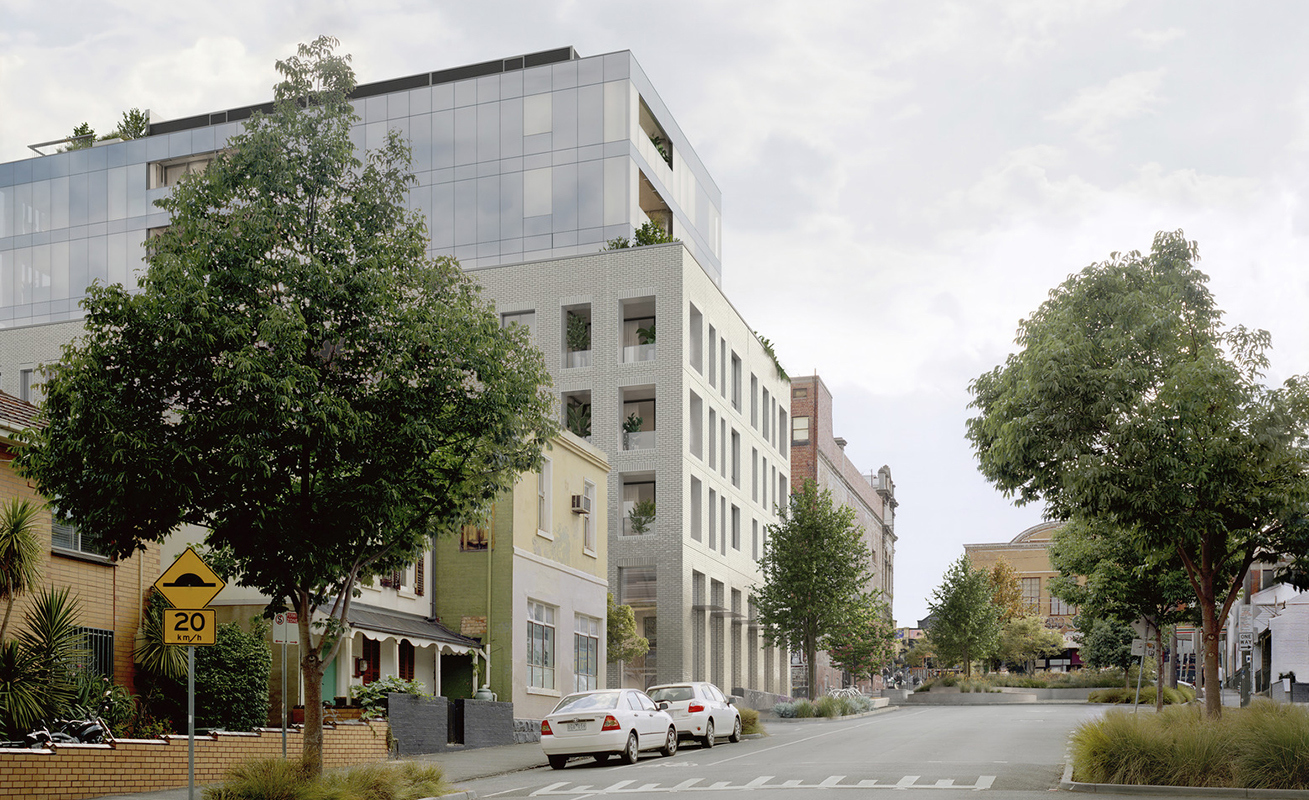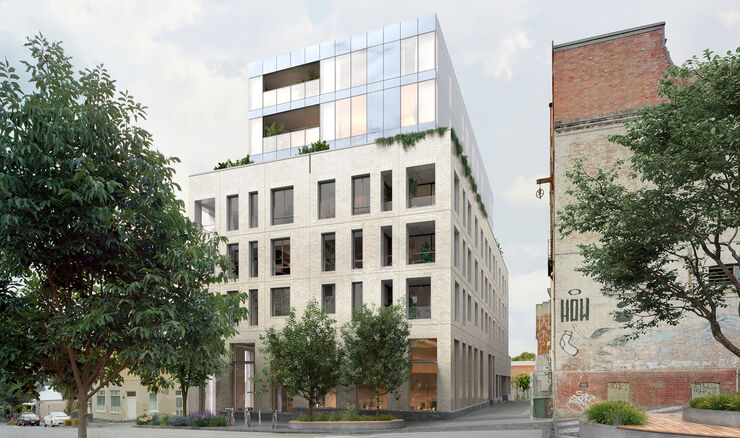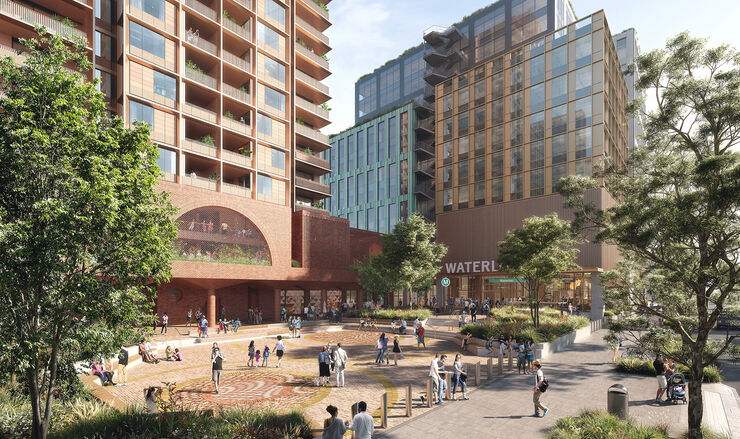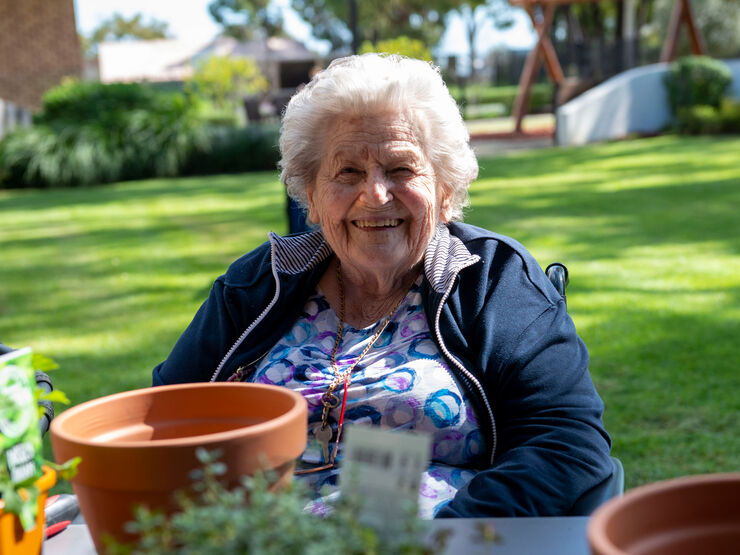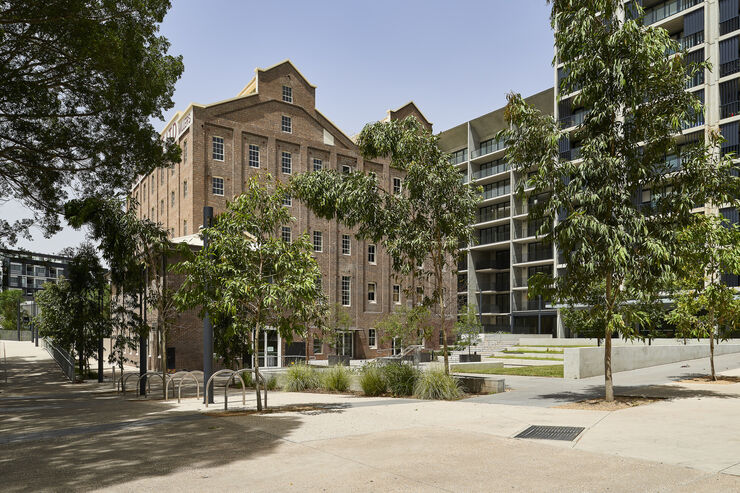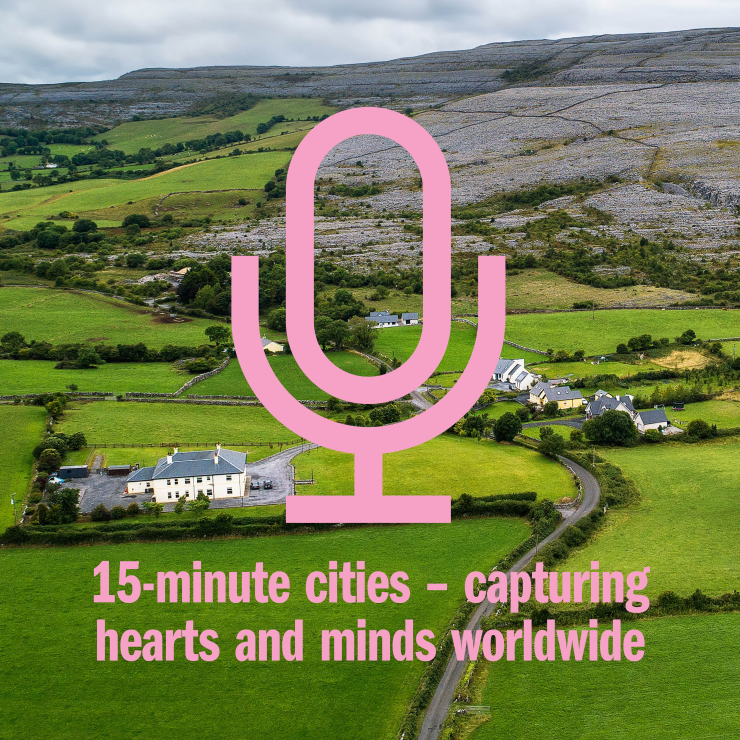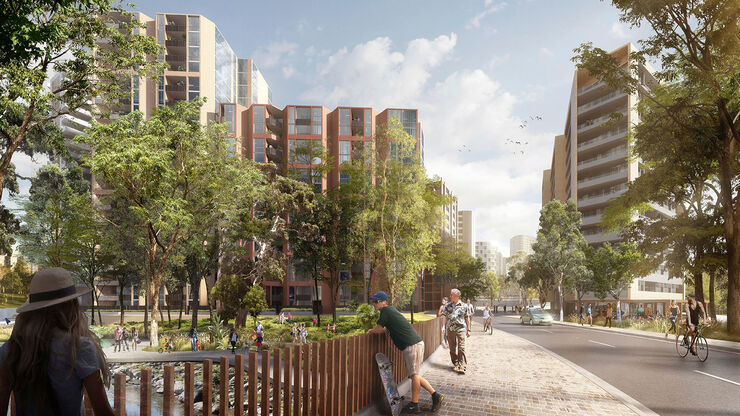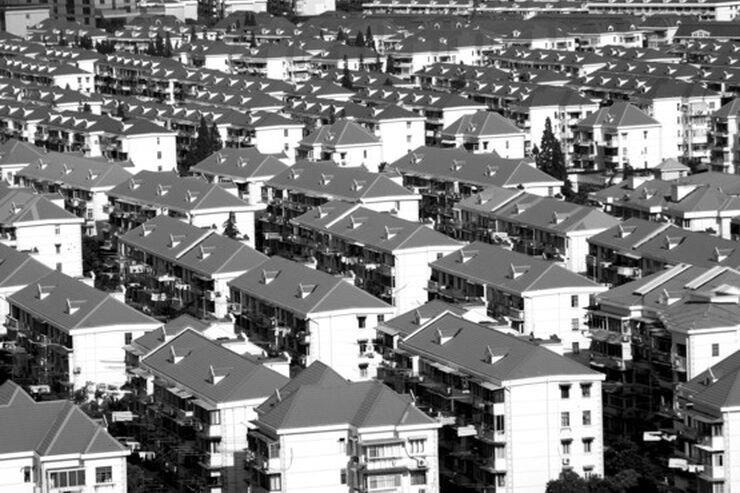Transcript
Jeremy Schluter speaks:
From Global Design Practice Hassell, this is Hassell Talks, a podcast series looking at a changing and complex world and the opportunities for design to create a better place for everyone. It’s a series that is unashamedly optimistic about creating a beautiful, inclusive, and resilient future. I acknowledge the Wurundjeri, Woiwurrung people of the Kulin Nation, their elders past and present as traditional owners of the land of Naarm or Melbourne where I live, work, and play, and pay my respects to the First Nations people across Australia as custodians of these lands.
I’m Jeremy Schluter. I’m an architect and I co-lead the residential sector at Hassell, which means I spend a lot of time thinking about how we live and how we can live better. They say there’s no place like home. For many in Australia right now, there literally is no place to call home. Put simply, we are around 1,000,000 homes short of what we need to have enough shelter for the current and expected population growth.
We’re not alone with this challenge, of course. Cities in Sweden, Germany, Greece, Ireland and France are all experiencing an acute rental shortage. No surprises that in an absence of options for housing, the housing affordability crisis places incredible pressure on markets, one part of a cost of living crisis impacting both buyers and renters. The market is ready, desperately so, to see alternatives to housing that will ease this challenge.
To explain what I mean by housing alternatives, 10 years ago we thought homes could only be a house and a suburb or an apartment in a tower in the city, and now we know there’s an entire spectrum. There are more ways to live now, from townhouses to subdivided housing units, to public affordable private investor rentals built to rent, premium owner occupy apartments and increasingly quality apartment options, specifically targeting families and the first home buyer. If you live in Melbourne, you may have heard of Nightingale and Assemble’s built to rent to own model that do just that.
Intersecting these is an eager, educated market who knows design. They know about sustainability and climate challenges. They’ve lived through the pandemic, so they need to be able to work comfortably from home with a supportive community around them. They also desire green space and amenities. So could we be on the cusp of a whole new range of housing alternatives? Is the housing crisis leading us to embrace new design solutions for our homes and cities? I wanted to pick the brains of a couple of people right in the thick of this, people and organisations exploring and investing in alternative housing models to see just how much this housing crisis is leading to new design solutions for our cities.
Michael McCormack is the co-founder and Managing Director behind small but mighty development firm Milieu. Milieu’s reputation for crafting beautifully conceived apartments that are sustainable quality homes for people has resulted in a bit of a following in cities such as Melbourne and Sydney, with Milieu’s buildings gaining fans, awards and accolades. Just don’t call them a luxury developer.
Milieu have built a strong reputation as one of the good guys. Their projects are driven by a strong social conscience and embedded in their local communities, which you’ll hear about in this episode. I am lucky enough to work with Milieu and Mike in Hassell’s design for Otter Place by Milieu, 28 residential apartments in the heart of Collingwood, currently under construction. We’ll pop a link in the show notes so you can check it out. Milieu’s work to me enriches the argument that inner-city living results in viable, appropriate and sustainable options and the success here has the potential to influence all new design solutions. I started by asking Mike about the appetite out there for the Milieu approach. What has he noticed about the common threads connecting people and projects?
Michael McCormack speaks :
Overwhelmingly, the people that look to our projects have a strong interest in design and passion for design and appreciation of design. I would say that there’s a social mindedness to them as well for sure, but there’s various ends of the spectrum. But just generally there’d be a social conscience, people that are purchasing our property, so there’s an interest in the social initiatives that we do, but also environmental policies, environmental performance of the projects. I’d say that they are usually quite astute and mature and want a sense of providence and a sense of uniqueness in their homes.
For us, we’re super aware that the number one decision about where people choose to live is not the building that they’re living in. It’s the area that they’re living in and they’re choosing an area based on, I guess a whole bunch of things, but often to do with the culture within the area and the community within the area. So we’re super aware that we benefit greatly from the community and the culture within that area, and it’s to our benefit to foster that and contribute to that.
So we do a bunch of things. We have a hospitality business, which works long after we’ve been developing the property. It continues to foster community and contribute to community through the ground plane of our buildings. We also work with local arts organisations like CCP, who’s in Fitzroy, and support them and contribute to them. Through our hospitality business, we have a for-purpose initiative called Open Kitchen, which at least it was born out of COVID where we were looking to provide meals for people that had lost their jobs or didn’t have any support, and that’s continued on.
We are a certified B corporation, which has a whole bunch of social initiatives as part of our commitment to that certification. It’s a really quite interesting relationship as a property developer recognising all the juxtaposition between what we do and First Nations, and we’re aware of that, but we look to respond to that through the scheme paying the rent.
Jeremy speaks:
That social element is really important and it’s certainly one of the things we’ve noticed of the work that you guys do, is taking responsibility for the culture, the community, and the social legacy of each of those buildings, each of those places. Because too often we see a 7-Eleven or a nail sell on or a vacant shop left on the ground plane of some of these residential developments.
Michael McCormack answers:
Completely. Most built to sell developments are sold off the plan and they’re sold through beautiful brochures and developers put a lot of work into preparing amazing renders and amazing collateral. As part of that, they produce these amazing renders of wine bars and cafes and stuff like that, but what they’re focusing on is selling the predominant part of the building, which is everything above ground floor, and they often forget about the small sort of 100, 150 square metre space at ground floor, but that space does so much to contribute to the community and can be such a positive, but also if you get it wrong, negative part of the development.
We’re also aware that that space, if you don’t own one of our buildings or own one of our apartments or know someone that does, it might be the only thing that you interact with. So it might be the only time that we have an opportunity to present a positive light from a brand perspective. So yeah, for us it’s a super important space and we put a lot of effort into our ground plan.
Jeremy asks:
What do you think they’re increasingly looking for lately in response to… There’s obviously a lot of trends impacting the housing market at the moment. The pandemic is a bit of history, but it’s still, I think, impacting our homes and what people are looking for. There’s also the cost of living crisis, rising inflation, energy costs and housing affordability in that. I know there’s a lot in there, but are there some common themes and threads that people are looking for more so these days?
Michael McCormack answers :
I think you touched on a lot of it just then, but tackling some of it. An attainable house for sure, like a good quality home. We’re not a luxury developer by any means. We never want to be a luxury developer. We certainly have seen off the back of COVID a real desire to have space and even your own space. A number of people that have been looking at our apartments most recently potentially have been renting a share house or with friends and they’re looking to buy an apartment now to have their own sense of space, and if they owned a place and they were in an apartment, they’re certainly now looking for more space, in particular spaces that they can use during the day.
Obviously a study is a big one for working from home, but a sense of community we’re seeing, absolutely, and not a forced community, but a casual community, not organised events necessarily, but knowing that you have a neighbour and you can run into them in the hallway, and just that idea of casual community I think is a really compelling thing at the moment after we’ve all spent a lot of time away from each other.
Jeremy asks:
Here’s a big topic. How do you think the changing face of the Great Australian Dream and the housing affordability challenge is influencing the future of Australian housing living and/or the residential market?
Michael McCormack responds:
When we started, we started in response to that, trying to provide attainable homes for people and good quality attainable homes, but we were looking at it from an owner occupied perspective. Then over the course of the last five years, project scale has typically got smaller, focused on owner occupiers, but most recently, there is a new type of development built to rent, which has increased the scale and it’s focused on renters like those projects were in a sense, but in this case, I feel like it’s a much better outcome, a much more quality outcome because the owners are all so a single entity focused on delivering a great outcome for renters, they have to.
Jeremy says:
In some ways, I feel like it’s been a challenge and it’s been a lot for people to get their heads around this evolving idea of the house with the picket fence and the home ownership, but in some ways, as the challenge evolves, it has opened up new housing options, new housing alternatives and new housing models and innovations, particularly in Australia that have meant that there’s more choice out there for how people want to live, where they want to live. And I think in some ways that’s quite exciting.
Michael McCormack responds:
Oh, I completely agree. I can imagine a world now off the back of COVID and the advances in technology, both from working from home, but also autonomous vehicles and built to rent and all the things that have going on. In the not too distant future, I can see people having a property in the city that they don’t own, but they rent as well as a property that might be more affordable regionally and spending time working from that regional property because that’s so much more able to be done now, commuting when they need to commute through an autonomous vehicle. Again, I don’t feel like it’s that far away, and then staying in Melbourne at their rental or property.
Yeah, I think it’s exciting in terms of the advancements and again, the challenges that have created opportunities through COVID but also the advancements in technology.
Jeremy comments:
And that was about changing from the demand for a home to being able to convince the market that you can get all of that closer in an apartment if the apartment is high enough quality.
Michael McCormack responds:
Yeah, definitely. I think housing is becoming really expensive to build, and property, buying land is becoming really expensive to build, so the response to that is higher density housing, and as that becomes more accepted and a more mature market, hopefully the market will push us to deliver really great quality higher density housing, and then we need to focus on all the spaces outside of the housing. One of my favourite places, and maybe this is because I’ve been a tourist when I’ve been there, but I love Paris because it has really quite great… If you live in the middle of Paris, you live probably in an apartment and it’s a very consistent five level height. There’s not a lot of high rise. It’s just a very consistent five level height, but there is a lot of amenity people use. There’s not so much internal amenity within apartments except there’s those large private courtyard areas, but I think that idea of that shared civic amenity is such an important tribute of high density living.
So one, I guess that the idea of apartment living, I think that’s certainly matured and people are becoming more comfortable with the idea of living in apartments, but the idea of owning your own home, and that might be an apartment, certainly still has its challenges. And I think the idea of creating better rental properties that have security of tenure and are like owning your own home, you can do things with them that you would if you owned the property and giving people the flexibility and I guess the freedom around that is the future of, I guess, residential living, particularly in the cities, I feel.
Jeremy asks:
Where do you think sustainability fits in these days?
Michael McCormack answers:
It’s not what we lead with. It’s a pillar of our projects, but that doesn’t mean that it’s not super important. It’s just not all that we are. I think there’s particular brands outside of development, but also in development that have that as their lead. And I think if you look at what we do from a sustainability perspective, the type of work that we’re doing is on parallel with their work from a sustainability credentials perspective, but it’s not what we leave with.
So we have a saying or an approach to sustainability as sustainability is standard. It should be standard in all projects and it should be a really important part, but it shouldn’t be… It’s not an amazing thing to have a sustainable building. It just should be done. And we try and focus on the big moves in buildings, not the add-ons and not the fancy things, but getting the building right from the outset.
Jeremy comments:
In some ways, I’d almost argue that that is not a revolutionary, but a unique and progressive way to look at sustainability, where it should be a fundamental, it should be a baseline. It shouldn’t be something that separates or is unique.
Michael McCormack responds:
Oh, absolutely. I feel like to what I was talking about before about how amazing developers are packaging up projects these days. One of the parts of that in particular markets is an arms race on sustainability. And I think it’s all about star ratings and tick and just a checklist of things that you can put in your brochure that you’re doing. But yeah, often it’s the stuff that is not easily described in a brochure that’s the big moves in a project that’s just as important.
Part of the problem of built to sell development, but also what can lead to great change and be a real strength is that it’s purchase or lead. It’s certainly developed as a driven by the market in selling apartments, and there’s definitely a growing consciousness or conscience around sustainability. So I think it’s in a pretty good spot. I’d like to see, and it’s certainly a policy of ours, no gas in residential buildings. It’s not required and it’s one of the very big moves that you can do to improve the sustainability credentials of your projects, and it’s certainly something that’s absolutely a policy of ours.
And then beyond that, I think cars, this obsession with cars. All of our projects are in… Literally, you could walk to the city of the project that you and I are doing together, mate, in Collingwood. People love the convenience of the car, but my bet is at Otter Street, when people purchase there, most of the week they’re not using their car. So how do you create an opportunity for them to feel comfortable not to have a car when they’re still on the weekend, might want access to a car? So I’d love to see more developments with share cars within the developments that allow people to have access to an electric vehicle, but not necessarily own a car themselves when it’s just sitting in a car park five days a week.
Jeremy says:
I think one of the interesting challenges, conversations around the car is we know cities and planners want all basement parking and they don’t want any parking above ground, but we’re seeing some developers push back on that with providing flexible mobility hubs above ground that can be converted in a few years based on actual user demand, more possible in a built to rent project where you can monitor use and if they’re not getting used, you can tweak the size of your car park, hard to do in a basement.
Michael McCormack says:
Yeah, I think that’s really interesting. A couple of our projects, we’ve been forward-looking and working with our design team around what those spaces might be in the future, because buildings are here for a long time, and I don’t think it’s that far away between autonomous cars and less people owning cars. And then you’ve got all these basements that need to have alternate uses. So how do you create something for those spaces, or can you think about that now so that they can be used in a different way in 20 years?
Jeremy:
Is there someone or a developer or a designer or a project that you are not involved in that you think is doing that really well and is pushing the residential market, the future of our homes in the right direction?
Michael McCormack :
Completely. Absolutely, I’m a huge supporter and fan of other developers’ work to the point where we started, we actually started this initiative called Building Better Cities, and it was born out a number of friends of mine are architects, just because I spend all day at work and therefore my friends are the people that I hang out with and-
Jeremy laughs and says:
We’re also great people, but-
Michael McCormack laughs and says:
Yeah, of course. Of course. So I go along to these architectural awards or architecture evenings, and what I saw was such a collegial, collaborative, supportive bunch of people that would get excited about each other’s projects and provide input and support. And I was like, “Why doesn’t that exist in the development industry on a scale it does in the architecture world?” And I came to the conclusion that developers, we’re all bloody competitive, super competitive in what we do, and you want the commercial edge in everything that you’re doing because it’s very competitive. You’ve got to buy sites and you’ve got to find the edge.
So we’re pretty closed and we don’t share, but I’ve been following a number of developers both in Melbourne, in Australia, but also overseas. That inspired me and I reached out to a number of these developers outside of Australia because I thought, well, they’re not competing against us, so therefore everyone’s probably more comfortable to share. Also, share some of the challenges that they had, be open and honest about the challenges they had, but also share projects and what’s worked well.
And to my surprise, a number of the developers that I’d followed and loved for some time, they were really keen to be a part of this initiative. So what we do is we catch up once a month or so and we share with each other. It’s like a counselling session almost, it feels at times, where we talk about-
Jeremy interjects and says:
A developers shed.
Michael McCormack laughs and responds:
Yeah, it’s really good. We talk about the projects that we’ve got on, some of the challenges, what’s worked well, but we also inspire each other and some of the work. So the people that are a part or the groups that are a part of that. There’s a group out of Brooklyn that is pretty similar in nature in terms of they’re very localised to us called Alloy. There’s a really amazing creative developer out of BC in Canada called Aryze. And in the UK there’s another developer called Parabola that is part of that group.
But Melbourne, probably maybe because I know the market so well, but also I think Melbourne has bred a really great cohort of developers. We’re working with Neo Metro, we’ve just finished a project with Neometro, and yeah, they inspired me when I first started our business, and I think they’re still doing great work. I think Nightingale do amazing work and really push all of us to improve on many levels.
Developers, there such a negative connotation about developers. Even like I was surfing this morning out at Tullamarine at the surf park out there, and someone asked me what I did, and I always feel a bit odd saying I’m a property developer. The conversation doesn’t usually go past that point, or very far at least often. And the perception is that we all wear blue pin striped suits and looking at Excel spreadsheets with dollar signs on them.
But for us, we try and think about it differently and change the perception of developers. We really feel that what we do is creative and we call it creative development, and we feel like we’re part of the creative process rather than a director of it or just instructing our collaborators that we work with. So I guess, yeah, we’re certainly trying to change the perception of developers.
Jeremy concludes the podcast:
It’s been a couple of months since I recorded this chat with Mike, and these challenges are certainly still front and centre of the property debate. The continued global complexities and cost of living challenges do seem destined to stick around, for now at least, but the opportunities are also just as relevant. With so many housing alternatives to consider, housing alternatives that do a better job of sustainability, community connection, providing green spaces and better living outcomes, the future looks bright. In a discerning market when costs are tight, quality design and scrutiny over what people are buying and renting has never been more important. Delivering quality housing with humanity will provide real choices and confidence to the community, a housing future that designs better cities and enriches lives.
Our next chat in this Housing Future series looks to that larger city scale and some of those real housing choices in a bit more detail. So look out for that one coming soon. Thanks to Mike for his time, his investment into providing quality housing and his enthusiasm in this topic. And thanks to you, our listeners. We know you’re as passionate about the role design plays in creating a beautiful, resilient and inclusive future as we are. I’m Jeremy Schluter. You’ve been listening to an episode of Hassell Talks. This episode was produced by Prue Vincent.
